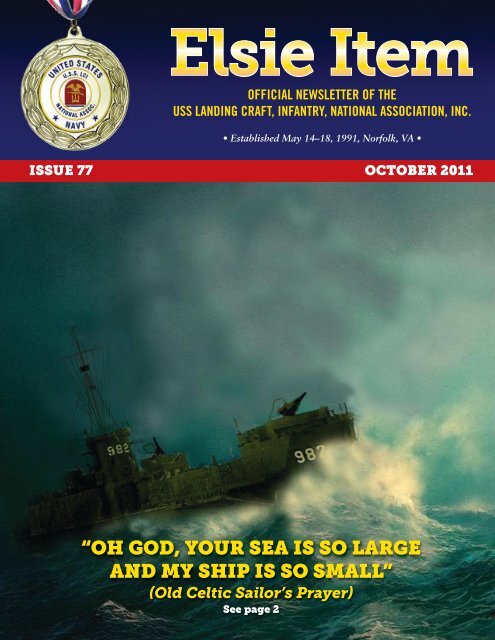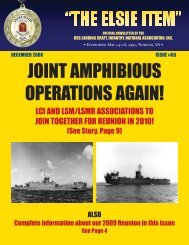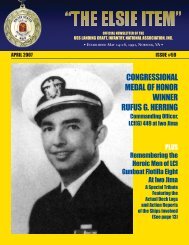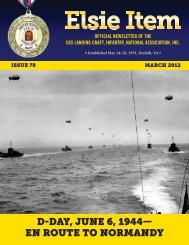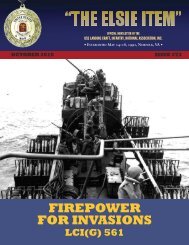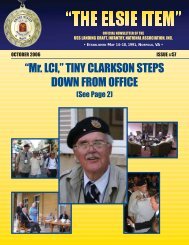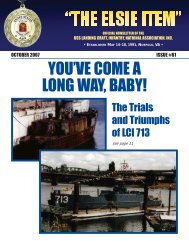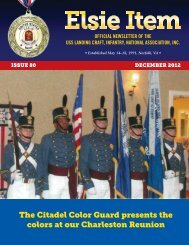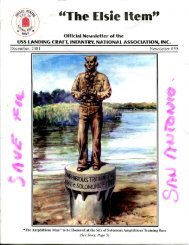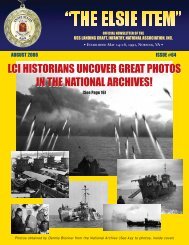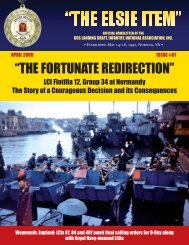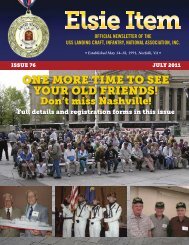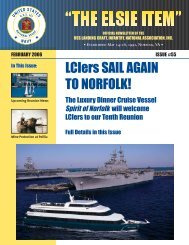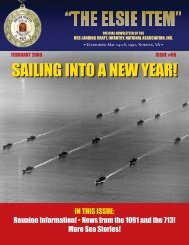âOh GOd, yOur sea is sO larGe and my ship is sO smallâ
âOh GOd, yOur sea is sO larGe and my ship is sO smallâ
âOh GOd, yOur sea is sO larGe and my ship is sO smallâ
Create successful ePaper yourself
Turn your PDF publications into a flip-book with our unique Google optimized e-Paper software.
OFFICIAL NEWSLETTER OF THEUSS LANDING CRAFT, INFANTRY, NATIONAL ASSOCIATION, INC.• Establ<strong>is</strong>hed May 14–18, 1991, Norfolk, VA •<strong>is</strong>sue 77 OCTOBer 2011“Oh <strong>GOd</strong>, <strong>yOur</strong> <strong>sea</strong> <strong>is</strong> <strong>sO</strong> <strong>larGe</strong><strong>and</strong> <strong>my</strong> <strong>ship</strong> <strong>is</strong> <strong>sO</strong> small”(Old Celtic Sailor’s Prayer)see page 2
“The elsie iTem” numBer 77, October 2011Official publication of the USS LCI National Association, a non-profit veteran’s organization. Member<strong>ship</strong> in the USS LCINational Association <strong>is</strong> open to any U. S. Navy or U.S. Coast Guard veteran who served aboard a L<strong>and</strong>ing Craft Infantry, toanyone related to an LCI veteran, or to anyone just interested in the h<strong>is</strong>tory of LCIs. Publ<strong>is</strong>hed quarterly by the USS LCI NationalAssociation. John P. Cummer, Editor. Any material for possible publication should be sent to the Editor, preferably by email(cummerj@bellsouth.net) or by regular mail to 302 Pinewood Cottage Lane, Blythewood, SC, 29016.about Our CoverTh<strong>is</strong> dramatic picture of an LCI in heavy <strong>sea</strong>s was produced by Ken Adair, a Vietnam Navy veteran himself <strong>and</strong> the son of a WWII LCIer.“I have always wanted to honor <strong>my</strong> dad's service, wrote Ken “Th<strong>is</strong> print was part of that honor <strong>and</strong> <strong>is</strong> one of more that will beproduced.”The original print was computer generated by Ken to be used in a painting of the <strong>ship</strong> in rough <strong>sea</strong>s. The computer generated printturned out so well that he decided to keep it as a print for d<strong>is</strong>play.The original print <strong>is</strong> of the 982 during a typhoon in the Pacific that Ken’s father went through along with h<strong>is</strong> <strong>ship</strong>mates.California lCi Group sets december 3for pearl harbor day luncheonOceanside, CA will be the setting for the 15th Annual Pearl Harbor Day Luncheonfor California LCI sailors <strong>and</strong> their guests. All USS LCI National Association.members are welcome. Joe Flynn, State Director for California writes:“If you happen to be v<strong>is</strong>iting southern California in December, come on in, thewater’s fine <strong>and</strong> the chow <strong>is</strong> great. All you need <strong>is</strong> your LCI cap <strong>and</strong> at least one<strong>sea</strong> story.”Oceanside <strong>is</strong> about 40 miles north of downtown San Diego. For information, call,write or email: Joe Flynn, 627 Bradford Rd, El Cajon, CA. Telephone: 619-588-7078 (Home) or 619-884-7078 (Cell Phone). Email: joeglo@msn.comOOps!The Gremlins did a job on the <strong>ship</strong> numbers of four Life Members who made donations publ<strong>is</strong>hed in the last <strong>is</strong>sue. We knowhow important <strong>ship</strong> numbers are. We apologize to each of these men. Here are the correct l<strong>is</strong>tings for these generous men:George J. Doyle, LCI 685, wrongly l<strong>is</strong>ted as LCI456W. Ralph Holloway, LCI (G) 22, wrongly l<strong>is</strong>ted as LCI 329Vernon E. Malmqu<strong>is</strong>t, LCI 948, wrongly l<strong>is</strong>ted as LCI 741James T. Roberts, LCI(G) 438, wrongly l<strong>is</strong>ted as 3732 | ELSIE ITEM | October 2011
a Word from thepresident/editorOur Nashville reunion was another great success!With our LSM friends there were over 300 in attendance. The fellow<strong>ship</strong> <strong>and</strong> camaraderie were as warm as ever <strong>and</strong>, along withenjoying seeing <strong>ship</strong>mates <strong>and</strong> their families again, we had some great sight-seeing experiences. The dinner cru<strong>is</strong>e aboard theriverboat SS Jackson gave us beautiful scenery, a fine meal <strong>and</strong> wonderful entertainment all in the ambiance of th<strong>is</strong> large replica ofthe steamboats that used to ply up <strong>and</strong> down the rivers of America. It was a bit of a dip into the past. And, of course, our v<strong>is</strong>it tothe Gr<strong>and</strong> Ole Opry was equally memorable. Some of us heard music we hadn’t heard for a long time! On Saturday our Chaplain,Mike Gatton, led us in an impressive memorial service <strong>and</strong> we topped it all off with a gr<strong>and</strong> banquet. You’ll see some pictures of itin th<strong>is</strong> <strong>is</strong>sue.Our relations with the LSM/LSMR Association could not have been better. After the reunion their President, Dave Miller, wrote: “Iwant to say thanks to you <strong>and</strong> all the other LCI members for another great reunion. The more we get together it seems that we havebeen doing th<strong>is</strong> for a long time.” Our members feel the same way about the LSMers.I want to share with you <strong>my</strong> optim<strong>is</strong>m about the future of our Association. Undoubtedly the most significant factor <strong>is</strong> the number ofenthusiastic, dedicated associate members who have taken leader<strong>ship</strong> roles: John France, Vice President; Steve Dudrow, Secretary;Mike Gatton, Chaplain; H<strong>is</strong>torian <strong>and</strong> on-coming board member Denn<strong>is</strong> Blocker; Joe Flynn, Director; <strong>and</strong> Robert Wright, Directorwill soon be joined by Diane Cochrin, our first lady board member. That’s an impressive team <strong>and</strong> we can have confidence in theirability to guide us in the future.We do have a financial challenge but the Board of Directors will be meeting via conference call in the near future to design ourresponse to that challenge. Several ideas for fund ra<strong>is</strong>ing are being considered.In th<strong>is</strong> <strong>is</strong>sue you’ll learn about one new program for ra<strong>is</strong>ing funds by rewarding you with newly-designed hats, shirts <strong>and</strong> jackets.Look at the pictures on page 26 <strong>and</strong> send in your order. Hint: think Chr<strong>is</strong>tmas gifts! We’re grateful to new Board Member RobertWright for spear-heading th<strong>is</strong> program.Along with some great <strong>sea</strong> stories in th<strong>is</strong> <strong>is</strong>sue, you will also read about Diane Cochrin, our newest Board member. Her appointmentto the Board strengthens the impact of associate members. Diane has been very supportive of our Association in a number of ways.Least but not last, you’ll read about the plans being made for next year’s reunion.—John CummerOctober 2011 | ELSIE ITEM | 3
at the nashville reunion!Shipmates John Reulet, Leo Wilcox <strong>and</strong> Roy Wetzel, LCI(G) 70together again for the first time since WWIThe color guard from Nashville’s McGavock High SchoolAir Force JROTC present the colors at the banquet.Treasurer Hal Bleyhl <strong>and</strong> wife, Pat, enjoy the banquetMarion Kunitsky, LCI(FF)427 <strong>and</strong> wife Beverlyat the memorial service4 | ELSIE ITEM | October 2011New Board Member Diane Cronin <strong>and</strong> her father enjoy a dance
next year – Charleston!After lengthy d<strong>is</strong>cussions among ourselves <strong>and</strong> with our friends from the LSM/LSMR association the dec<strong>is</strong>ion was made to holdanother joint reunion next year, September 9-14, in Charleston, South Carolina.An important reason for selecting Charleston was the large number of our members who live in the eastern half of the country,particularly in the states on the <strong>sea</strong>board.Charleston <strong>is</strong> a lovely, h<strong>is</strong>toric city with a d<strong>is</strong>tinct nautical background. Until recently it was home to a large Naval Base.We will be meeting at the Sheraton Charleston Airport. The room rate, single or double, <strong>is</strong> $109, plus tax (13.5%). Th<strong>is</strong> rateincludes complimentary breakfast <strong>and</strong> free parking. The hotel will offer complimentary airport shuttle as well as shuttle to theH<strong>is</strong>toric D<strong>is</strong>trict <strong>and</strong> to nearby shopping malls.Full details will be forthcoming in future <strong>is</strong>sues of Elsie Item. For now, be sure to mark your calendars!introducing our newest directorDiane Cronin, daughter of Harold Cronin, LCI 635, has accepted appointment to the Board ofDirectors of the USS LCI National Association.A resident of Lake Luzerne, New York, Diane <strong>is</strong> the Senior Accountant for the Adirondack MountainClub. She earned her Bachelor of Science in Business at Charter Oak State College. Starting withher father, Diane has a strong affinity for military matters. She <strong>is</strong> a lifetime member in both theAmerican Legion Auxiliary <strong>and</strong> the Veterans of Foreign Wars <strong>and</strong> has engaged in lobbying forveterans <strong>and</strong> civic programs at the state <strong>and</strong> federal government levels. Welcome aboard, Diane!October 2011 | ELSIE ITEM | 5
ough rideacross the atlantic:a Coast Guardsman’s storyAs told to Jim FinklerbyWilliam D. Elder,Boatswain’s Mate 1st Class, LCI(L)89Jim Finkler, another participant in the “Remembering LCI Veterans” FaceBook, shared the news of the passing of William D. Elder.He wrote:My close friend <strong>and</strong> personal hero William D. Elder, USCG Boatswain's Mate 1c on LCI(L)89 January 1943-July 1944, passed away inClifton Springs, NY on Saturday, Sept. 24, 2011. Bill was a veteran of Operations Torch (Tun<strong>is</strong>ia), Husky (Sicily), Avalanche (Salerno,Italy), <strong>and</strong> Overlord (Norm<strong>and</strong>y, France). He also served on the Cutter USCGR Condor in 1942, served at the USCG Station atToledo,OH from late 1944-February 1945, <strong>and</strong> was 2nd in comm<strong>and</strong> of the USCG Station at Mackinac Isl<strong>and</strong>, MI from February 1945until h<strong>is</strong> d<strong>is</strong>charge, reserve enl<strong>is</strong>tment, on October 13, 1945. Bill was 90 years old.I'm sure that he <strong>and</strong> Robert Harker are already swapping stories.We regret that Bill Elder left us before he could see h<strong>is</strong> story in print.CONQUERING THE ATLANTICI was full of excitement with the idea of leaving the UnitedStates, <strong>and</strong> I did not sleep well. Up earlier than usual, I wenttop side, <strong>my</strong> mind still on our departure despite having manyflashbacks of home.Up the ladder to the poop deck. My h<strong>and</strong>s were cold from theheavy frost on the ladder rungs. I wanted to double-check thelife rafts. My thoughts were still on <strong>my</strong> folks back home as Istarted down the ladder. Oops! I slipped <strong>and</strong> fell to the deck,into the stanchion cable. That knocked the wind out of me butkept me from falling overboard. As I lay dazed on the deck,Chief Lauve was just coming out of the engine room hatch sawme lying on the deck <strong>and</strong> came running up to me.“Are you alright?”My head was still spinning. He got me in a sitting position.“I think I’m OK.”He helped me up. As the shock wore off, I realized <strong>my</strong> rightankle hurt.“Chief, I think I broke <strong>my</strong> ankle!”“I’ll get Doc - Stay still.”Doc was our pharmac<strong>is</strong>t mate, Clayson. The ankle began toswell. I was in great pain. Doc examined <strong>my</strong> ankle. “You mayhave fractured it. I’m going over to the hospital to pick up somesupplies I ordered. I’ll take you with me. We’ll get the ankle x-rayed.”Doc <strong>and</strong> I left for the hospital. As I could not put <strong>my</strong> weight on<strong>my</strong> right foot, he helped me into the jeep that was assigned toour <strong>ship</strong>. At the Navy hospital, he pulled up to the front door,6 | ELSIE ITEM | October 2011
hopped out of the jeep <strong>and</strong> ran inside to get a wheelchair forme. On the way to the check-in station he explained oursituation to the nurse. They got a doctor right away <strong>and</strong> rushedme to the x-ray room. Holding up the X-rays, the doctor studiedthem saying, “No fractured bones. You tore up your ankle verybadly. You’ll have to stay off that foot for awhile. We’ll get yousome treatment for the ankle. I’ll have them get you a room.”As I was wheeled down to the lobby, <strong>my</strong> mind was reeling: Ican’t stay in the hospital - I’ve got to get back to the <strong>ship</strong>. Iwonder where Doc <strong>is</strong>. I don’t want to be left behind. What can Ido? I was deeply concerned about what would happen to me.From behind I heard a voice. I turned. It was Doc. “How did youmake out?” Happy to see him, I said “I’m okay!” Before I couldthink, I said “Let’s get out of here!” Doc had a box in h<strong>is</strong> h<strong>and</strong>s.“I’ll take th<strong>is</strong> out to the jeep <strong>and</strong> come back for you.”Give me the box <strong>and</strong> let’s get going.” I got the box <strong>and</strong> out wewent.As we left in the jeep, Doc asked, “What did the doctor say?”“He said no fractures. I’m to stay off <strong>my</strong> foot for several days.”“OK, I have crutches on board. We’ll put some hot packs on theankle.” “Yea! The doctor said that’s what I should have.”When I arrived at the <strong>ship</strong> some of the guys saw us <strong>and</strong> cameout to meet us. “How you doing, Boats? Is it broken?” Theyhelped me aboard the <strong>ship</strong>.The exec came over to me. “Heard about your accident. Glad tosee your return.”“Me too.”“You take it easy. I’ll be talking to you later.”Our Chief Cook/Steward for the Officers, James Zachery—Zak—brought me some bean soup he had made for the noon chow.“Here Boats, th<strong>is</strong> will make you feel better.”“Yeah! I’ll be farting <strong>my</strong> way to Bermuda.” He chuckled. H<strong>is</strong>round face, big white smile, big eyes, just lit up h<strong>is</strong> brown face.October 2011 | ELSIE ITEM | 7
You just had to love the guy. Our young cook, David Johnson,was way over h<strong>is</strong> head trying to cook for the <strong>ship</strong>’s crew. So, thecaptain made Zak our head cook, <strong>and</strong> Johnson h<strong>is</strong> ass<strong>is</strong>tant.That made Dave happy. It made a good arrangement. He couldlearn from Zak, <strong>and</strong> better chow was making the crew happy.About 1400 I could hear the engines start. The crew was movingup to top side. The LCIs started to sail out of Port Norfolk.Outside the harbor the flotilla formed into a convoy of six <strong>ship</strong>sin four lines. I could feel that we had about four-foot <strong>sea</strong>srunning. It was sloppy going into the night off Cape Hatteras,the winds picked up <strong>and</strong> the <strong>sea</strong>s got up to six- <strong>and</strong> eight-footwaves. I could feel the 89 rolling, tossing, banging down. Whenshe would bang down the <strong>ship</strong> just shuddered. I had a veryuncomfortable night.After the evening chow, Doc put some hot packs on <strong>my</strong> ankle. Iconfessed to him that the doctor was making arrangements toput me in a hospital room.“That explains why you were in such a hurry to get away fromthe hospital. You had it made! Just think you could have gottenout of th<strong>is</strong> deal.”“I know. But I wanted to stay with the <strong>ship</strong> <strong>and</strong> get into theaction.”The crew started to get “salty,” an expression for a <strong>sea</strong>sonedsailor. Everybody was getting to know each other. We werebonding. On the third day I was starting to feel better. Sun wasout. That afternoon we sailed into Port St. George, Bermuda. Itwas warm <strong>and</strong> a great site for us, with deep blue water <strong>and</strong>white s<strong>and</strong> beaches. It was exciting. The guys were alreadytalking about getting liberty. The port <strong>and</strong> the buildings <strong>and</strong>everything looked so clean -- a great sight. The water was soclear you could see 30 to 40 feet down to the bottom.Here <strong>is</strong> where we got our training on the 20 MM guns. Theshooting range was on the other side of the <strong>is</strong>l<strong>and</strong> up on a highbluff. Our targets were pulled by airplanes. I was able to getaround for th<strong>is</strong> training. I did very well with the 20 MM gun. Ipicked up on th<strong>is</strong> type of shooting. The targets were pulledbehind the airplane at about 90 to 100 miles per hour. It waslike shotgun shooting at flying targets. I was brought up ongame bird shooting, hunting grouse, woodcock, ring-neckpheasant, <strong>and</strong> quail with a shotgun. You had to lead these fastflying birds at different angles. Th<strong>is</strong> came to me naturally withthe 20 MM gun shooting at these moving targets. The web sightring mounted on the gun helped you for your d<strong>is</strong>tance <strong>and</strong>leading the target. Also, the tracer bullet indicated your lead onthe target. Every fourth round in the magazine was a tracer.Th<strong>is</strong> helped me get <strong>my</strong> timing to get on the target quickly. Ienjoyed th<strong>is</strong> training. It was very challenging. I was cited for <strong>my</strong>20 MM gun shooting. They assigned me the gunner on the<strong>ship</strong>’s bow gun. Th<strong>is</strong> became <strong>my</strong> battle station during GeneralQuarters during ene<strong>my</strong> alerts.The crew got liberty here at St. George. They toured the <strong>is</strong>l<strong>and</strong> bybicycle, had a few beer beach parties. It didn’t take long for th<strong>is</strong>to get old. Th<strong>is</strong> <strong>is</strong> about all a sailor could do here. My tour of the<strong>is</strong>l<strong>and</strong> was to <strong>and</strong> from the shooting range due to <strong>my</strong> bumankle. I caught the navy bus up to the shooting range. Iwatched the shooting <strong>and</strong> v<strong>is</strong>ited with the marine gunnersdoing the 20 MM gun training.On the 10th of April, we departed Port St. George. Here werendezvoused with a very large convoy sailing east. It was agreat site to see all these <strong>ship</strong>s. There were over a 100 <strong>ship</strong>s,troop transports, freighters, <strong>and</strong> oil tanker <strong>ship</strong>s. Eightdestroyers <strong>and</strong> twelve destroyer escorts flanked the convoy. Attimes they would sail up through the convoy.Our first few days into our voyage were smooth sailing withwarm sunshine. We all were nicely getting settled in with ourroutine, with a four hour watch every twelve hours. Zak wasserving us very good chow. He did wonders with h<strong>is</strong> menuscooked on oil stoves. At times there was no great hot chow, forthe LCI would pitch <strong>and</strong> roll so severely that even a genius couldnot cook a meal. We would resort to K-rations <strong>and</strong> cold spam.Sometimes the weather got sloppy with strong winds <strong>and</strong> heavy<strong>sea</strong>s. St<strong>and</strong>ing watch with these heavy <strong>sea</strong>s on the bridge <strong>and</strong>fly bridge became an unforgettable workout. It was likeclimbing up a snowy mountain-side <strong>and</strong> then sliding, losingyour balance, <strong>and</strong> falling down, then climbing up again <strong>and</strong>falling down again. I’d go below from watch on the bridgefeeling like a tenn<strong>is</strong> ball bru<strong>is</strong>ed from the bounces. The windwould wh<strong>is</strong>tle throwing the spoon drift up from the wavesagainst the LCI’s bridge port lights it would feel like beingsprayed with a water hose.She’d ride up a mountainous <strong>sea</strong>, all 160 feet of her; then slapdown hard into the trough shuddering all along her hull. Thewave would crunch against the deck tower. The water rolled offher decks. You couldn’t imagine what it was like in an Atlanticstorm on the LCI. Roll! Pitch! L<strong>is</strong>ten to the water as she wouldshudder <strong>and</strong> creek. The guys would chant, “Roll <strong>and</strong> Pitch youS-O-B! Old washboard’s starting up again.” That’s exactly whatit was like, a washboard. Our LCIs didn’t have the rolling motionof a destroyer. The flat bottoms were not a d<strong>is</strong>placement hulllike a normal <strong>ship</strong>. We rode on top of the water like a wood chip.8 | ELSIE ITEM | October 2011
The lasT lCiA son d<strong>is</strong>covers h<strong>is</strong> father’scomm<strong>and</strong> in the Pacific WarBy Henry AllenHenry Allen <strong>is</strong> the son of the Henry Allen who skippered the 1091from Bay City, MI through the battle of Okinawa <strong>and</strong> then toJapan. He <strong>is</strong> a Pulitzer Prize-winning journal<strong>is</strong>t while writing forThe Washington Post. After he retired he wrote the h<strong>is</strong>tory of h<strong>is</strong>d<strong>is</strong>covery of the 1091 for a magazine called Military H<strong>is</strong>tory.In submitting th<strong>is</strong> story to us, Henry remarked “How proud hewould be to know that the 1091 <strong>is</strong> the flag<strong>ship</strong> of the LCIassociation!”William Faulkner wrote a lot of things worthy of the NobelPrize. One of them was th<strong>is</strong>: “The past <strong>is</strong> never dead. It’snot even past.” Call it Faulkner’s Law, <strong>and</strong> here <strong>is</strong> how I learnedthe truth of it.My father, Lieutenant Henry S. Allen Jr., comm<strong>and</strong>ed a <strong>ship</strong> inWorld War II, LCI(L)-1091.It wasn’t a big <strong>ship</strong>—158 feet long—but it was h<strong>is</strong> <strong>ship</strong>, <strong>and</strong> hewas <strong>my</strong> father, so it loomed huge in <strong>my</strong> boyhood imagination, alegend, a <strong>my</strong>th. I am 68 now, <strong>and</strong> it still looms.A photograph of 1091 hangs on a wall in <strong>my</strong> studio, a gray<strong>and</strong> dirty combat <strong>ship</strong>, forging against a bow wave, lookingsomehow tired on a cloudy day when the kamikazes weren’tattacking at Okinawa, or more likely when the battle—thelargest amphibious assault of World War II, with almost 5,000American sailors killed <strong>and</strong> nearly 30 <strong>ship</strong>s sunk—had finallyended.Hanging beside the photograph are a souvenir samurai sword,a tatter of 1091’s long, thin comm<strong>is</strong>sioning pennant <strong>and</strong> <strong>my</strong>father’s ribbons—a shrine to a lost era of Americans fighting innot just a worthy cause but a victorious one. I’ll pass along theshrine-tending duties to <strong>my</strong> oldest son when I die, along with theribbons <strong>and</strong> photographs from <strong>my</strong> time as a Marine in Vietnam.L<strong>and</strong>ing Craft Infantry (Large) were big enough to cross thePacific Ocean, small enough to l<strong>and</strong> a company of infantry on abeach—in North Africa, Anzio, Norm<strong>and</strong>y, Iwo Jima, everywhere.Armed with five 20mm cannon, some also carried rocketlaunchers, mortars or .50-caliber machine guns for close-inwork.Good <strong>ship</strong>s with a lot of uses.More than 900 LCIs were built, starting in 1942—so manythey were given numbers, not names. No glamour, no first ladieschr<strong>is</strong>tening them with champagne bottles, just workhorses.Coming into beaches, they made big targets for ene<strong>my</strong> artillery,which sank a lot of them.A year after that battle—where suicide planes had come outof the sun for months, <strong>and</strong> the waters around 1091 had heavedwith corpses—I watched <strong>my</strong> father slide the photograph from amailing tube <strong>and</strong> unroll it on a table in our living room. I sensedeven then he saw things in it <strong>my</strong> mother <strong>and</strong> I could not. I wastold not to touch it.Dad framed the picture. It traveled with us from house tohouse.When I was little, he told me stories about 1091, but only thefunny ones, like the one about the cooks, Loskutoff <strong>and</strong>McMasters, who used a baseball bat both to stir dough for acrew of about 30 <strong>and</strong> occasionally to go after each other.Later he told me about taking 1091 from the Defoe <strong>ship</strong>yard inBay City, Michigan, down the Great Lakes to the Chicago River<strong>and</strong> finally out to the M<strong>is</strong>s<strong>is</strong>sippi, where he saw country womensitting on the banks nursing babies—a starchy Yankee, he wasshocked.Then through the Panama Canal to California, with stops atHawaii, Guam <strong>and</strong> Eniwetok on the way to Iwo Jima, where hearrived late in the battle <strong>and</strong> was ordered to keep going to thenext one, Okinawa, where he <strong>and</strong> 1091 would spend almost threemonths in combat. The LCI defended battle<strong>ship</strong>s againstkamikazes with its guns <strong>and</strong> hid them with a smoke generator.“We were next to the Iowa when they fired the big guns,” <strong>my</strong>father told me. “The concussion picked up our whole <strong>ship</strong> <strong>and</strong>tossed it.”He watched Marines with flamethrowers moving like dutifulpostmen from cave to cave. He watched thous<strong>and</strong>s of Japanesecivilians jump to their deaths from cliffs at the end of the battle.10 | ELSIE ITEM | October 2011
LT Allen’s <strong>ship</strong>, the 1091, in mint condition shortly after comm<strong>is</strong>sioning.“Women with babies in their arms,” he said.I’d know more if <strong>my</strong> mother hadn’t thrown away all h<strong>is</strong> lettersfrom the Pacific. He’d meant them as a chronicle.On a Sunday afternoon in October 1952, <strong>my</strong> father <strong>and</strong> I sat onthe couch in front of our 12-inch black-<strong>and</strong>-white TV to watch ashow we’d anticipated for months: Victory at Sea.French horns sounded the show’s signature theme while agrim ocean rolled behind the titles. My father’s face took on aseverity <strong>and</strong> alertness—h<strong>is</strong> war face, h<strong>is</strong> comm<strong>and</strong> face. I thinkit was then I began to sense that the war had been the mostimportant <strong>and</strong> meaningful time of h<strong>is</strong> life.I watched Victory at Sea with him every week, <strong>and</strong>, just asimportant, I watched him watch it. We both waited for spring<strong>and</strong> the end of the war, when we’d see footage of Okinawa, h<strong>is</strong>battle. An old-school Princeton gentleman, he d<strong>is</strong>dained showsof emotion, but the Okinawa segment undid him.The planes came in toward the cameras, endless kamikazestwitching through anti-aircraft fire, <strong>and</strong> <strong>my</strong> father rose halfwayfrom the couch, pointing <strong>and</strong> shouting: “Get him! Get him!Starboard bow, get him! Get him!”I was startled, even alarmed. I knew better than to ask himabout it.After the war, LCIs would gradually van<strong>is</strong>h from the Navy. Myfather had no idea where 1091 had gone. There was no Internetthen to find such things.One day we were driving along the East River in Manhattan,<strong>and</strong> he saw a Circle Line boat—a converted LCI, he said. But tryas I did, I could not d<strong>is</strong>cern any vestige of h<strong>is</strong> legendary vessel insome tour boat hauling families with hot dogs <strong>and</strong> cameras.Dad grew into middle age, became a salesman for asilverware company, then a sales manager. Evenings at ourhouse faded into the preoccupations of an alcoholic haze.I was on a school trip when a fellow LCI captain from Okinawacame to v<strong>is</strong>it with h<strong>is</strong> wife. I w<strong>is</strong>h I’d been there to l<strong>is</strong>ten. All Iheard about it was <strong>my</strong> mother’s repeated complaint: “Good God!All they could talk about was the Navy.”Every Chr<strong>is</strong>tmas he sent cards to h<strong>is</strong> crew. Every Chr<strong>is</strong>tmas hegot fewer back.On the back of one picture of h<strong>is</strong> crew in dress blues he hadOctober 2011 | ELSIE ITEM | 11
quoted Tennyson in pencil:My mariners,Souls that have toil'd, <strong>and</strong> wrought, <strong>and</strong> thought with me—That ever with a frolic welcome tookThe thunder <strong>and</strong> the sunshine, <strong>and</strong> opposedFree hearts, free foreheadsFifteen years after Okinawa, when he was suffering tragicreverses—personal, financial, corporate—our phone rang.It was a 1091 sailor, now a successful funeral director, <strong>and</strong>he’d called to thank <strong>my</strong> father for inspiring h<strong>is</strong> r<strong>is</strong>e in life. Iremember Dad walking back into the living room shaking h<strong>is</strong>head with a gratitude that verged on tears.He died in 1982, already senile at the age of 71, <strong>and</strong> Iinherited all h<strong>is</strong> pictures of 1091 <strong>and</strong> its crew, a briefcase full oforders <strong>and</strong> the navigation charts of Okinawa he’d inscribed witha pencil <strong>and</strong> a straightedge.One night in 2001, I was in the shower, where I do some of <strong>my</strong>best thinking. I realized that if <strong>my</strong> father’s LCI was numbered1091, there must have been a lot of them <strong>and</strong> a lot of sailorswho sailed on them.I dried off, booted up <strong>my</strong> computer <strong>and</strong> punched “l<strong>and</strong>ing craftinfantry” into a <strong>sea</strong>rch engine. Amazing! There was a big LCIorganization—veterans who held conventions <strong>and</strong> celebratedtheir service in what they called the “Gator Navy” or “WaterbugNavy.” They had hats, badges, postcards, pins, medallions,calendars <strong>and</strong> a sticker for kids reading, MY GRANDMA MARRIEDAN LCI SAILOR.How I w<strong>is</strong>hed <strong>my</strong> father were alive to know it. The next night,on a wild off chance, I tried punching in “LCI-1091.”What I saw brought me out of <strong>my</strong> chair, shouting to <strong>my</strong> wife: “Ifound <strong>my</strong> father’s <strong>ship</strong>! I found the 1091!”Of all the LCIs built in all the world, the only one left intact—or so it was believed then—was <strong>my</strong> father’s, <strong>and</strong> it was mooredin Eureka, Calif. Its owner was a dent<strong>is</strong>t named Ralph Dav<strong>is</strong>,who was restoring it to World War II condition. Somehow, despiteany failures, <strong>my</strong> father was redeemed, <strong>and</strong> I, in <strong>my</strong> boyhooddreams, was justified. The past <strong>is</strong> never dead. It <strong>is</strong>n’t even past.I learned more of h<strong>is</strong> <strong>ship</strong>’s h<strong>is</strong>tory. After a stint at the BikiniAtoll atomic bomb tests <strong>and</strong> l<strong>and</strong>ings in the north during theKorean War on spy m<strong>is</strong>sions to <strong>sea</strong>rch for the presence ofbubonic plague (they found smallpox), 1091 returned statesideto Astoria, Ore., <strong>and</strong> was sold to a f<strong>is</strong>hing company that used itfor 20 years on the Yukon River.Dav<strong>is</strong> bought it in 1989. He had always wanted to be captainof a <strong>ship</strong>. He’d hoped to join the Navy but had been drafted intothe Ar<strong>my</strong>, which trained him as a dental ass<strong>is</strong>tant. He had apractice in McKinleyville, Calif., up in redwood <strong>and</strong> marijuanacountry. He’d never owned any boat larger than an aluminumrunabout with a little outboard motor. But Dav<strong>is</strong> not only bought1091, he sailed it down from the Pacific Northwest <strong>and</strong> moored itin Humboldt Bay. Once a year, with h<strong>is</strong> wife, First Mate BobbieJo, he took it out albacore f<strong>is</strong>hing.I called Dav<strong>is</strong>. He knew nothing of the <strong>ship</strong>’s early h<strong>is</strong>tory. Wearranged for me <strong>and</strong> <strong>my</strong> oldest son, Peter, to fly out there inAugust from Washington, D.C.“We’ll show you a good time,” Captain Ralph said. The greattreat was to be breakfast in Eureka’s Samoa Cookhouse, a hugemess hall that once fed lumberjacks.Before our trip, I made more calls, sent more messages. Ifound a crewman: quartermaster <strong>and</strong> signalman Loyel “Bud”Hoseck. He’d spent the Battle of Okinawa st<strong>and</strong>ing on theconning tower beside <strong>my</strong> father, working signals. Now he wasretired in Minnesota. He told me stories <strong>my</strong> father had not.“The first night we got to Okinawa, four kamikazes came in atsunset, coming so close you could almost touch them,” he said.“The battle<strong>ship</strong> M<strong>is</strong>souri was a block away. A kamikaze hit it;there were 41 killed.”Hoseck had kept a diary <strong>and</strong> written a brief memoir. He sentthem to me. They told of torpedo boats, suicide barges <strong>and</strong> 1091gunners shooting up floating boxes <strong>and</strong> crates on the chancethey might be bombs propelled by suicide swimmers; how the<strong>ship</strong> was on the beach at Ie Shima , delivering a tank, whenErnie Pyle, the famous <strong>and</strong> beloved war correspondent, waskilled a hundred yards away; how they threw away bad mutton<strong>and</strong> chicken from Australia <strong>and</strong> lived on little else but macaroni<strong>and</strong> cheese, a diet so tedious that K-rations were a treat. Theyhad a phonograph but only one record: “Don’t Fence Me In.”“At night when the big <strong>ship</strong>s were shelling the <strong>is</strong>l<strong>and</strong> <strong>and</strong>shooting over us, we would have to strap ourselves in our bunks,or the concussion would flip you right out of your bunk,” Budsaid. “One strap was across our chest <strong>and</strong> another across ourhips. Sleep was hard to get.”And there was a story <strong>my</strong> father never told me, perhapsbecause of the ending. Bud remembered a kamikaze “that washit hard <strong>and</strong> the pilot couldn’t steer h<strong>is</strong> plane into a <strong>ship</strong>. It hitthe water a couple hundred feet from our <strong>ship</strong>. After the bigsplash, we couldn’t believe it when the pilot surfaced.…We puta rope ladder for him to climb; we thought we might as well takehim pr<strong>is</strong>oner.…As the Jap reached the edge of the <strong>ship</strong>’s deck,we offered him a h<strong>and</strong> to help him aboard. That’s when hepulled a knife <strong>and</strong> was going to get one more American. The guyswith guns were alert, <strong>and</strong> a couple of blasts sent him tumblinginto the ocean. One wanted to go down the ladder <strong>and</strong> get h<strong>is</strong>helmet; they had nice leather headgear.…We didn’t let him godown. But as a comment <strong>and</strong> don’t want to dwell on, somemilitary personnel used to recover the gold teeth of dead Japs.”May 12, 1945: LCI blown up by suicide plane, two survivors.Planes strafed <strong>and</strong> killed engineering officer <strong>and</strong> two men onLSM-414. Had been moored alongside them the day before.Suicide plane crashed into New Mexico, killed about 150 men. I12 | ELSIE ITEM | October 2011
saw it come in at dusk, out of sun.May 28, 1945: Low-flying Jap plane blown up right off ourstarboard bow. My birthday <strong>and</strong> a lonely one. LCI hit.June 24, 1945: Close shave with death. An APD was hit by aJap suicide plane. We were to escort her to Ie Shima but ourorders were changed at the last minute <strong>and</strong> an LSM <strong>and</strong> an LCStook our place. Three Jap suicide planes came in low, radarfailed to pick them up. Sunk all three <strong>ship</strong>s, just a few survivors.Lucky our orders were changed.And then there’s the laconic entry of a combat-weary sailorwell past making a big deal out of anything.August 6, 1945: A-bomb Hiroshima. Mail run. Got severalletters.And the war ended. Bud claimed 1091 was alongside M<strong>is</strong>souri,delivering mail, when the Japanese signed their surrender.Others have doubted th<strong>is</strong>. We may never know.In more than a year, they spent only two or three days off the<strong>ship</strong>, <strong>and</strong> one of the first places they l<strong>and</strong>ed for liberty wasNagasaki.I asked Bud how he liked <strong>my</strong> father.“That was another world, the officers,” he said. (There werefour officers on 1091.)I sensed he was ducking the question.What did he think of him as a skipper?“He was a good skipper. Your dad would pride himself onbeing a good navigator.” (Later, in the reserves, Dad wouldnavigate the battle<strong>ship</strong> New Jersey into New York Harbor.)I heard a careful reserve in Bud’s voice. I told him not to worryabout insulting me.“He was very particular,” he said, finally, as if he’d had to lookfor a way to say it. “Very particular, set in h<strong>is</strong> ways. One day hecame into the pilothouse when I was at the wheel. He reachedover to a porthole, ran h<strong>is</strong> finger along it <strong>and</strong> said, ‘Dust.’”Bud paused, still infuriated, it seemed, after all these years.“Dust.”Particular: I remember that too. I could mow the whole lawn,<strong>and</strong> the only part he’d see was the one blade of grass I’dm<strong>is</strong>sed—a “holiday,” he’d call it, from sailor lingo he’d learnedfrom chipping paint on merchant <strong>ship</strong>s during summervacations in college.Now to retrieve <strong>my</strong> father’s <strong>ship</strong> from legend <strong>and</strong> st<strong>and</strong> on theconning tower where he stood.That August <strong>my</strong> son Peter <strong>and</strong> I flew to Eureka. Captain Ralph<strong>and</strong> h<strong>is</strong> family—wife <strong>and</strong> First Mate Bobbi Jo <strong>and</strong> h<strong>is</strong> daughterRuth—met us at the tiny airport. He was a bright-eyed guy withh<strong>is</strong> glasses down on h<strong>is</strong> nose. He wore an LCI hat <strong>and</strong> the air ofan eccentric who, with no previous oceangoing experience, wouldbuy a <strong>ship</strong> <strong>and</strong> take it from Washington State to California.“We’ve got it all set up for you,” he said. “We’ll be out on the1091 tomorrow morning after we eat that breakfast I prom<strong>is</strong>edyou about at the Samoa Cookhouse.”Eureka <strong>is</strong> a faded lumber <strong>and</strong> f<strong>is</strong>hing town str<strong>and</strong>ed 280 milesnorth of San Franc<strong>is</strong>co, so far north that Highway 101 revertsinto a two-lane road. The ocean <strong>is</strong> so cold <strong>and</strong> the air so dankthat beaches are always empty. The average high temperature inAugust <strong>is</strong> 64. It has the feel of a museum of lost eras, a relicdecorated with its heyday’s Victorian houses <strong>and</strong> hippies whohadn’t changed for 30 years, with VW microbuses <strong>and</strong> a baffledlethargy.After a breakfast so vast it was humbling, we drove down tothe water, bumping through the scrub <strong>and</strong> rusty barbed wirefences of never-happen shoreline real-estate schemes. My firstglance was over bushes, <strong>and</strong> there was no doubt: the conningtower with mast <strong>and</strong> rigging.“There she <strong>is</strong>,” I said.“That’s right,” said Captain Ralph.1091 was tied to skewed pilings in tidal flats. We camealongside in an outboard motorboat while one of the manyfriends of the <strong>ship</strong> videotaped our arrival for h<strong>is</strong>tory, h<strong>is</strong>torybeing what th<strong>is</strong> was all about.Up a ladder, <strong>and</strong> then the impossible was possible, thelegendary real. The past <strong>is</strong> never dead...“Here it <strong>is</strong>,” I said. It was all I could think to say, <strong>and</strong> all Ineeded to say.Like other Navy <strong>ship</strong>s I’d been on, it was impersonal <strong>and</strong> cozyat the same time, rivets <strong>and</strong> beams, all gray metal or paint—Navy <strong>ship</strong>s seem to be built as much of gray paint as anythingelse. I felt as if I wasn’t v<strong>is</strong>iting the <strong>ship</strong> as much as reclaimingit, a patrimony. Our feet rang on ladders, we smelled the eternalpaint <strong>and</strong> diesel smell of <strong>ship</strong>s, we saw marks on the deck wherethe gun tubs had been (Get him! Get him!).In the galley we pictured the cook bracing against cabinets,stirring batter with the storied baseball bat as the <strong>ship</strong> rocked—it was a l<strong>and</strong>ing <strong>ship</strong> <strong>and</strong> only drew 5 feet of water, with no keelto grip the water beneath the waves.We toured dim labyrinths of troop <strong>and</strong> crew compartments litby bare bulbs, <strong>and</strong> I remembered troop<strong>ship</strong>s in which I’d lain on<strong>my</strong> rack—canvas strung between pipes—hearing the PacificOcean h<strong>is</strong>s past steel plating.My father’s quarters, topside, had a porthole <strong>and</strong> the originaldesk. I imagined him scrambling from h<strong>is</strong> rack up to the conningtower during yet another night attack, the crew racing along withhim to general quarters—sprinting to the gun tubs in helmets,down to the dank sweat of a diesel-roaring engine room, while<strong>my</strong> father peered into a night sky lit with dirty explosions <strong>and</strong> thecasual arcs of tracers.Except now, of course, it was a cool <strong>and</strong> quiet morning innorthern California.My son <strong>and</strong> I posed for pictures on the conning tower ladderOctober 2011 | ELSIE ITEM | 13
where <strong>my</strong> father stood a million years ago to have h<strong>is</strong> picturetaken, too. My son wore the same hat h<strong>is</strong> gr<strong>and</strong>father wore. Istood at the wheel in the pilothouse where Bud Hoseck wouldst<strong>and</strong> a watch at the helm. I did not look for dust.Feeling both intensely alone <strong>and</strong> intensely scrutinized, Iclimbed to the conning tower <strong>and</strong> looked out over the well deck tothe gigantic power winch on the bow <strong>and</strong> beyond to the bay. Isaid a prayer, nothing in particular, just a sort of offering to thegods of war, fathers <strong>and</strong> memory.In the years since 2001, 1091 has become a museum mooredin downtown Eureka, a tour<strong>is</strong>t attraction. It serves meals cookedin the galley <strong>and</strong> ladled onto mess trays. It has a dues-payingmember<strong>ship</strong> association. LCIs are prospering, it turns out:Another one, 713, <strong>is</strong> being restored in Portl<strong>and</strong>, Ore.“I brought the original comm<strong>is</strong>sioning pennant,” I said toCaptain Ralph.“Let’s run it up,” he said.It’s faded now, a long thin thing with seven stars <strong>and</strong> twostripes, red <strong>and</strong> white. With rare exceptions, one flies from themast of every American war<strong>ship</strong>, a Navy ritual. Th<strong>is</strong> one flewwhen the <strong>ship</strong> powered out of the yard in Michigan.We ho<strong>is</strong>ted it, along with the American flag. Symbolically oreven technically, the pennant meant the <strong>ship</strong> was <strong>my</strong> father’s, orso I chose to interpret Navy regulations at that moment.It’s not even past.I saluted. I took a picture.Dad, I hope you know.14 | ELSIE ITEM | October 2011
d-day remembrancesA presentation made by Ralph Langenheim, LCI(L) 551 at a local D-Day CelebrationThe Crew of the 551. Engineering Officer Ralph Langenheim <strong>is</strong> the first officer to the left.I would like to tell you about the sensations I felt crossing in the night from Engl<strong>and</strong>’s coast to Norm<strong>and</strong>y in LCI(L) 551 with 225men--the Navy crew <strong>and</strong> the troops who were to l<strong>and</strong> at Utah Beach.I don’t remember the weather but the <strong>sea</strong> was calm. It was dark. We were in a large convoy with maybe as many as 100 dieselpoweredl<strong>and</strong>ing craft, so there was a subdued roar of engines that sort of undercut everything. It was, as I said, dark, <strong>and</strong> we wereapprehensive, of course, about what we were getting into. I don’t particularly remember being afraid. As we proceeded you had thesense of large forces <strong>and</strong> large events taking place which might, or might not, be part of our destiny.I remember the roar of many planes flying overhead towards the beaches. Some of them may have been the paratroopers that l<strong>and</strong>edat St. Lo: some might have been bombers softening up the beach--but none of these could be seen. And, for that matter, no lightswere showing on the <strong>ship</strong>s except a small blue stern light which we were following--the <strong>ship</strong> ahead in our formation. But you had thefeeling that you were moving into something large <strong>and</strong> quite foreboding.Eventually, we began to hear the d<strong>is</strong>tant sound <strong>and</strong> flash of explosions, bombs shelling the beach. As we kept approaching, we gotthe smell of explosives <strong>and</strong> finally, of course, with the approach of dawn, you began to see things around you--the <strong>sea</strong>scape wasfilled with <strong>ship</strong>s, mostly l<strong>and</strong>ing craft, but also transports, gunnery support <strong>ship</strong>s, <strong>and</strong> so on. As we approached Utah beach, wepassed a sunken destroyer--we later learned she had hit a mine. A mangled, bloody, body floated by, the only sign of carnage thatcame to our attention during the entire l<strong>and</strong>ing. We anchored off shore awaiting our turn to l<strong>and</strong>. That came in late afternoon.October 2011 | ELSIE ITEM | 15
The troops, most of whom were <strong>sea</strong>sick, remained below deck until about five o’clock when we received a radio order. At th<strong>is</strong> point,we upped anchor <strong>and</strong> formed a line, about fifteen abreast. The nineteenth wave was on its way. Finally we were doing what wecame to do.As we approached the beach, <strong>is</strong>olated splashes in groups of four appeared around us. We were under fire. However, the gunners whowere firing could not see us. They were firing blind.When we grounded on the beach, we extended <strong>and</strong> lowered our ramps <strong>and</strong> began d<strong>is</strong>charging troops into the relatively calm water.Heavily laden as they were, these heroic soldiers struggled towards shore but because the <strong>ship</strong> had grounded on an offshore bar,they quickly waded into water over their heads. One man carrying a radio on h<strong>is</strong> back was head down, feet out of the water,thrashing. Sailors on a grounded LCT, left behind in one of the morning l<strong>and</strong>ings, f<strong>is</strong>hed them out with boat hooks.As the troops d<strong>is</strong>embarked on Utah Beach, our <strong>ship</strong> rose in the water <strong>and</strong>, since the tide was r<strong>is</strong>ing rapidly, Captain Carideo, of NotreDame Football fame, had to continue to reground the <strong>ship</strong>. However, in the process a strong long-shore current carried usnorthwards, parallel to the beach, <strong>and</strong> I <strong>and</strong> <strong>my</strong> men had to unreel more cable to keep us in place. Eventually, we were forced toretract, pull ourselves off the beach, <strong>and</strong> beach the <strong>ship</strong> a total of three times--all amidst the general chaos <strong>and</strong> shell fire. Finally,the last of our troops were removed by small Higgins boats <strong>and</strong> we were, thankfully, free to leave.It was only later, much, much later, that we realized the part we had played in what Dwight D. E<strong>is</strong>enhower called in h<strong>is</strong> June 6, 1944,D-Day speech: “the elimination of Nazi tyranny over the oppressed peoples of Europe, <strong>and</strong> security for ourselves in a free world.”16 | ELSIE ITEM | October 2011
northwest lCiers meetThe Northwest LCIers are still meeting!LCI Director, Emeritus, Rod Scurlock reports, “We had 22 happy folks there <strong>and</strong> had a good time.”Speaker for the occasion was Dave McKay who told the group of the work that <strong>is</strong> being done on the restoration of LCI 713 <strong>and</strong> offuture plans for the vessel. The group met at the Quay Red Lion hotel in Vancouver, WA, on August 19th <strong>and</strong> 20th.L to R: FRONT ROW: Pat Bleyhl, Susan Menhorn, Ann Koeplin, Marie Brown, Lo<strong>is</strong> Metter,Beverly Barnett, Carol Stanley, Sharon Smith, Ruth Scurlock.BACK ROW: Hal Bleyhl, Charlie Ports, George Menhorn, Leroy Olson, Bruce Hallet, Rod Scurlock,Kr<strong>is</strong> Shelvik, Tom Barnett, Gordon Smith, Richard Nelson, John StanleyOctober 2011 | ELSIE ITEM | 17
A Thought fromChaplain Mike Gattonlessons learned fromthe Greatest GenerationChaplain Mike’s remarks at the reunion memorial service were so encouraging <strong>and</strong> impressive that we invited him to share them here.eVERY GENERATION LEAVES A LEGACY OF LESSONS TO BE LEARNED. But, there may never have been a generation whotaught more valuable lessons than the one born between 1914 <strong>and</strong> 1929. You were the folks who grew up during the GreatDepression. You are the men who went off to fight in the Big One. And, you are the men who came home from that war <strong>and</strong>built a nation into an economic powerhouse. You knew the meaning of sacrifice, both in terms of material possessions <strong>and</strong> of realblood, sweat, <strong>and</strong> tears. You were humble men who never bragged about what you had done or been through. You were loyal,patriotic, <strong>and</strong> level-headed. You were our Greatest Generation.Tom Brokaw gave you that name; <strong>and</strong> while it’s a bold claim, it has been earned. You weren’t perfect by any means, of course, butas a whole you were a cut above the rest. When I was taking a walking tour of LCI 713 at the Portl<strong>and</strong> reunion, I noticed the tiny,closet-sized kitchen where a couple of men prepared meals for the crew as the <strong>ship</strong> rocked to <strong>and</strong> fro, <strong>and</strong> I looked at the guns usedto ward off ene<strong>my</strong> planes. One tends to picture 30 year old guys doing that stuff; Tom Hanks <strong>and</strong> company always leap to mind. Buta lot of you were just 18, fresh from the prom <strong>and</strong> varsity football.In Brokaw’s book, The Greatest Generation, he remembers h<strong>is</strong> mother telling him the story of the day Gordon Larsen came into thepost office where she worked. Larsen was typically a cheerful <strong>and</strong> popular member of their community, but that day he had stoppedin to complain about the rowdiness of the teenagers the night before, which had been Halloween. Brokaw’s mother was surpr<strong>is</strong>ed ath<strong>is</strong> tone <strong>and</strong> asked him good naturedly, “Oh Gordon, what were you doing when you were seventeen?” Gordon looked at her squarelyin the eye <strong>and</strong> said, “I was l<strong>and</strong>ing at Guadalcanal.” He then turned <strong>and</strong> left the post office. You were men who were surely maturebeyond your years. Maybe it’s time we remember the lessons you have taught us <strong>and</strong> embrace once again the values of the GreatestGeneration.Lesson # 1: Take Personal Responsibility for Your Life. While today’s generation often shirks responsibility as too much work, yourel<strong>is</strong>hed the chance to step up to the plate <strong>and</strong> test your mettle. One son of a WWII Medal of Honor winner remembers of h<strong>is</strong> dad <strong>and</strong>h<strong>is</strong> peers, “For them, responsibility was their juice. They loved responsibility. They took it head-on, <strong>and</strong> anytime they could get a task<strong>and</strong> be responsible, that was what really got em’ going.” And when the Greatest Generation accepted responsibility for something,you also accepted all the consequences of that dec<strong>is</strong>ion, whether good or bad. You were not a generation of whiners or excusemakers. Unlike today when individuals <strong>and</strong> businesses reach for a bailout or an easy fix, you took pride in personal accountability.Lesson #2: Be Frugal. Is your house stuffed with doodads <strong>and</strong> boxes of stuff? Do you have a sort of pack rat mentality? Could it bebecause you grew up in the Great Depression where the next can<strong>is</strong>ter of oats or pair of pants was not guaranteed? You learned tolive on less <strong>and</strong> be grateful for the things you had, no matter how humble. It didn’t take a new Wii to brighten your Chr<strong>is</strong>tmasmorning; an orange at the bottom of a stocking was enough to knock your socks off. Th<strong>is</strong> was not the generation that purchasedCorvettes to soothe their mid-life cr<strong>is</strong><strong>is</strong>, nor the generation that equated success with the purchase of a McMansion. Th<strong>is</strong> was thegeneration that was thrilled to move into small suburban houses of 750 square feet—not as big as some of today’s garages. One ofthe mottos of the Greatest Generation was “use it up, wear it out, make it do, or do without.”18 | ELSIE ITEM | October 2011
Lesson #3: Be Humble. Typical of your generation <strong>is</strong> the story of a son or daughter who finds a war medal stashed in the attic afterdad passes, he having never told them about it. Even if your exploits had been brave <strong>and</strong> heroic, you rarely talked about the war—maybe because of the difficulty in remembering such carnage, but also from the sense that you had simply been fulfilling your duty,<strong>and</strong> thus had no reason to brag. Brokaw observes: “The World War II generation did what was expected of them. But they nevertalked about it. It was part of the Code.” There’s no more telling metaphor than a guy in a football game today who does what’sexpected of him—makes an open-field tackle—then gets up <strong>and</strong> dances around like some fool.Lesson #4: Love Loyally. You took your marriage vows seriously. Brokaw wrote, “It was the last generation in which, broadlyspeaking, marriage was a commitment <strong>and</strong> divorce was not an option.” Numbers bear Brokaw’s anecdotal evidence out: of all thenew marriages in 1940, 1 in 6 ended in divorce. By the late 1990s, that number was 1 in 2. Yours was a time when there was nohanging out or “hooking up.” Men asked women on real dates, <strong>and</strong> had serious intentions in doing so. When a particular gal caughta man’s heart, he proposed, <strong>and</strong> they got hitched. And they were married for the next 60 years. Maybe things wouldn’t be so badtoday, if we didn’t think there was an escape hatch, <strong>and</strong> we knew that whatever bumps in the road we hit, we had to work throughthem together.Lesson #5: Work Hard. In war, you learned to focus on the objective at h<strong>and</strong> <strong>and</strong> not give up until that objective <strong>and</strong> the m<strong>is</strong>sion asa whole was accompl<strong>is</strong>hed. When you got home, you carried that focus over to the world of work. They didn’t fall into the fallacy thatyou had to find “your passion” to be happy. You seemed to find happiness in any job you did, because you weren’t just working forpersonal, self-fulfillment; you labored for a bigger purpose: to give your families the financial security you hadn’t enjoyed growingup. As soon as they graduate college, many folks today want the things it took you 30 years to acquire. But, you knew that going intodebt was not the way to get the things you wanted. You understood that the good things in life must be earned by honest work.Lesson #6: Embrace Challenge. You weren’t the Greatest Generation despite the challenges you faced, but because of them. Todaytoo many shirk challenge <strong>and</strong> difficult pursuits, believing that the easier life <strong>is</strong>, the happier they’ll be. But you knew better. You knewthat one cannot have the bitter without the sweet, <strong>and</strong> that true happiness comes from overcoming the kind of challenges that buildcharacter <strong>and</strong> refine the soul. The challenges you experienced made your joy all the more sweet because it was tinged with thegratitude of knowing how easily it could all have been taken away.And, Lesson #7: Don’t Make Life So Dang Complicated. If there’s a common thread in these lessons, it’s having a common sen<strong>sea</strong>nd a level-headed approach to life. While today, we obsess about finding ourselves, or the perfect mate, or our passion in life, youruncomplicated approach to life <strong>is</strong> refreshing. You didn’t go on a diet, you simply ate whole food; you didn’t exerc<strong>is</strong>e, you workedaround the house; you didn’t obsess about your relation<strong>ship</strong>s, you just found a lady you loved <strong>and</strong> married her. You always lookedsharp, but never fussed with fashion trends. You didn’t mull over which appliance better suited your personality <strong>and</strong> image, you justbought the machine that worked the best. You didn’t think about how to get things done, you just did them. Instead of spendingtime navel-gazing your life away, you just got up <strong>and</strong> went. So simple!Thanks, gentlemen (<strong>and</strong> the ladies who love you), for lessons taught. YOU are the GREATEST!Agape, MikeOctober 2011 | ELSIE ITEM | 19
Thanks to Chaplain mike!At the reunion banquet Chaplain Mike Gatton was presented with a plaque by President Cummer to express our gratitude for h<strong>is</strong>many services to the USS LCI National Association. In h<strong>is</strong> typical gracious fashion, he expressed h<strong>is</strong> response, writing:Thank You! Through years of min<strong>is</strong>try <strong>and</strong> service to several organizations, I have received plaques <strong>and</strong> tokens of appreciation.There <strong>is</strong> only one of those d<strong>is</strong>played in <strong>my</strong> church study. It <strong>is</strong> the one received from you at our Nashville reunion. Never has an awardbeen more appreciated, but less deserved. It <strong>is</strong> I who should be giving each of you a plaque for the freedom I enjoy. My work withthe LCI Association has been a labor of love. Thank you from <strong>my</strong> heart. Mike20 | ELSIE ITEM | October 2011
IN MEMORIAM“Almighty <strong>and</strong> eternal God, from whose love we cannot be parted, either by death or life;hear our prayers <strong>and</strong> thanksgiving for those whom we here remember.”“Grant unto sorrowing family <strong>and</strong> <strong>ship</strong>mates the blessingof your peace that passes underst<strong>and</strong>ing.”LCI 2Gerald LiderLCI 23Charles R. PortsLCI 39Joseph B. AndersonLCI 66John J. BarryLCI 85Elmer E. CarmichaelLCI 89William D. ElderLCI 327Hassell, LavonneLCI 361Eugene H. AuberLCI 361Clark BrookLCI 362Norman E. Dav<strong>is</strong>LCI 373Sam AlaloufLCI 423Joseph P. MonterossoLCI 449Norman C. HolgateLCI 470Larry H. CurryLCI 474Robert J. HarkerLCI 545Eugene J. Lev<strong>and</strong>oskiLCI 561Richard D. BantaLCI 621Carl S. KohorstLCI 625James E. McDonaldLCI 665Robert VanKeurenLCI 756Roger MelroseLCI 801Paul J. KarpikLCI 1012Charles W. Edm<strong>is</strong>tenLCI 1018Bernard RohdeLCI 1022John H. MansfieldLCI 1057Bobby G. DulaneyOctober 2011 | ELSIE ITEM | 21
The story of an underage lCierByChet Collom, LCI 1097“I may be one of the youngest of the WWII LCI sailors as <strong>my</strong>18th birthday saw me in boot camp the day the atom bombwas dropped on Hiroshima”.So wrote Chet Collom as he submitted th<strong>is</strong> account of h<strong>is</strong>Navy life for us.When the Japanese bombed Pearl Harbor December 7, 1941 Iwas living in Glendale, California. With <strong>my</strong> family.I went on to Junior High School. On May 22, 1945 I joined theNavy <strong>and</strong> went to boot camp in San Diego. I had boot leave inAugust <strong>and</strong> on <strong>my</strong> 18th birthday, August 6, 1945, the U.S.dropped the first atom bomb on Hiroshima. Returning to SanDiego I was moved to San Bruno, California to receiveAmphibious training for the invasion of Japan proper.I arrived in Tokyo in September <strong>and</strong> was assigned to acommunications base in Kure,17 miles from Hiroshima.Ibecame a signalman striker. I was transferred again toYokosuka <strong>and</strong> assigned to the LCI(L)1097 where I met thecrew of twenty men <strong>and</strong> three officers.I asked Captain Gross to be signalman striker <strong>and</strong> was toldthey needed a quartermaster. I agreed <strong>and</strong> started studyingfor the grade.We took on stores, made a “Going Home Banner”, one footfor each crew returning. We were set to sail back to theStates when we were told of a huge earthquake in Alaska<strong>and</strong> we needed to move the craft to the middle of Tokyo Bayto watch for a tidal wave. As an 18 year old <strong>sea</strong>man 2c thereI was st<strong>and</strong>ing watch for a tidal wave! I had no idea howhigh it would be! Or what to do if it did hit!! It never came.The next day we sailed out of Tokyo into a huge typhoon forthree days. As long as I was on the helm I was OK -not <strong>sea</strong>sick- but otherw<strong>is</strong>e the only safe place to be was in the sack.When on the helm the power steering failed <strong>and</strong> I wasordered to the aft steering in the bilge area, taking orders toport <strong>and</strong> starboard to keep the <strong>ship</strong> heading straight into thewaves as a broadside wave could capsize us!We sailed the 1097 from Tokyo to Eniwetok, where we anchoredoff shore <strong>and</strong> I made a sketch of the atoll, enclosed, then, on toHonolulu. The sailing from Honolulu to San Diego took 2 weeksat 4 knotsWe stayed in San Diego, just 2 hours from home. In August wesailed to Acapulco where we had to stop to fix the galley’srefrigerator. Next we went through the Panama Canal <strong>and</strong> thento New Orleans where I received <strong>my</strong> Quartermaster 3c rating.The <strong>ship</strong> was then sent up the M<strong>is</strong>s<strong>is</strong>sippi River fordecomm<strong>is</strong>sioning. I went on to Norman, Oklahoma, ford<strong>is</strong>charge from the Navy.Chester (Chet) Collom20102 Lemarsh St.Chatsworth CA 9131October 2011 | ELSIE ITEM | 23
USS LCI NATIONAL ASSOCIATIONAPPLICATON FOR MEMBERSHIPIf you served aboard an LCI during WWII, are a relative of someone who served aboard an LCI, or ifyou just have a desire to have a part in remembering those who so served, you are invited to join ourassociation.Please complete th<strong>is</strong> form <strong>and</strong> mail it to the address indicated below with your first year’s dues.DUES ARE $25.00 PER YEAR, June 1 through May 31.Member<strong>ship</strong> includes a subscription to Elsie Item, our quarterly publication.I. For application if you served on an LCI:Name______________________________________________________________________________________Which LCI did you serve on?___________________ What was your Rank/Rate?____________________Address:___________________________________________________________________________________City: _______________________________________ State:__________ Zip:_________________________Date of Birth:________________________________ Phone #:________/____________________________E-mail address:_____________________________________________________________________________Occupation or Former Occupation: ____________________________________________________________Wife’s Name________________________________________________________________________________II. For Application if you did not serve on an LCI:Name______________________________________________________________________________________Address:___________________________________________________________________________________City: _______________________________________ State:__________ Zip:_________________________Date of Birth:________________________________ Phone #:________/____________________________Are you related to someone who served on an LCI? o Yes o NoIf so, what <strong>is</strong> the relation<strong>ship</strong>? (i.e. father, gr<strong>and</strong>father, uncle, etc) _______________________________What <strong>is</strong>/was h<strong>is</strong> name? _____________________________________________________________________On which LCI did he serve? ____________________Have you served in the U.S. military? o Yes o No If so, what branch?________________________Please send th<strong>is</strong> application with your check ($25) made payable toUSS LCI NATIONAL ASSOCIATION to:USS LCI National Associationc/o Nehemiah Communications, Inc.101 Rice Bent Way, Unit #624 | ELSIE ITEM | October 2011
your uss lCi association needs your supportOctober 2011 | ELSIE ITEM | 25
eunion picturesNew board member Robert Wright <strong>and</strong>Pacific H<strong>is</strong>torian Denn<strong>is</strong> BlockerAndrew Pomeroy, LCI 981 <strong>and</strong> wife Bettyattending their first reunionBeautiful prints of an LCI at sunset whichwere raffled off at the banquetBill <strong>and</strong> Betty Keeler show that they can still h<strong>and</strong>lethe dance floor. Bill served on LCIs 432 <strong>and</strong> 61526 | ELSIE ITEM | October 2011
your Officers <strong>and</strong> Board of directorsPlease feel free to contact any of the officers or directors l<strong>is</strong>ted below for whatever comments or questions you may have. If theperson you contact does not know the answer to your question, he will direct you to one who can. We’re here to serve you!OFFICERS:James E. TalbertChairman of the BoardLCI 61812238 Woodl<strong>and</strong> TrailCouncil Bluffs IA 51503(712)366-1094tab626@yahoo.comJohn P. CummerPresidentLCI 502302 Pinewood Cottage Lane,Blythewood, SC 29016(803)714-9098cummerj@bellsouth.netJohn FranceVice President11621 Copper Springs TrailOro Valley, AZ 85737(520)429-3792Lci540@aol.comHal BleyhlTreasurerLCI(L) 81210418 Campville St.Bo<strong>is</strong>e, ID 83709(208)639-9180hbleyhl@aol.comSteven DudrowSecretary5067 Vincitor Street,Las Vegas, NV 89135(941)416-0717stevedudrow@comcast.netRev. David CoxChaplain(LCI 633)413 Tupilo Way NWBirmingham, AL 35215(205) 854 -5229swabby1@bellsouth.netRev. Michael GattonChaplain6410 Gellhaus LaneLou<strong>is</strong>ville, KY 40299502/762-0613mgatton@insightbb.comBOARD OF DIRECTORSJim Aydelotte(LCI 25)3710 Goldfield Road #425Apache Junction, AZ(480-671-2425)Jj10723@aol.comGordon SmithLCI(L) 432313 Northeast 110th AvenueVancouver, WA 98684(360)256-5901gordonsharonsmith@gmail.comJoe Flynn627 Bradford RoadEl Cajon, CA 92019(619)588-7078joeglo@msn.comDiane CroninAssociate Member125 Gage Hill RoadLake Luzerne, NY 12846(518)696-2903dm_cronin@yahoo.comRobert E. Wright, Jr.Associate MemberPO Box 407Howell, MI 48843(517) 548-2326rewrightcpa@gmail.comHISTORIANS:John France,European Theater ofOperations11621 Copper Springs TrailOro Valley, AZ 85737(520)429-3792Lci540@aol.comDenn<strong>is</strong> BlockerPacific Theater of Operations2847 Cedar PlainSan Antonio, TX 78245(210)673-8854lci449@hotmail.comDIRECTORS EMERITUS:Connie R. MulherinLCI(G)5611520 Sea Gull DriveTitusville, FL 32796(321)268-1713cmulherin1@cfl.rr.comRod Scurlock(LCI 565)4445 Mustang DriveBo<strong>is</strong>e, Idaho 83709(208) 362-4447rhscurlock@yahoo.comBob McLainLCI 436)1829 Hemlock RoadLancaster, PA 17603-4437(717)392-4558maxeyusn@comcast.netOFFICES AND SUPPORT SERVICES ARE PROVIDED BYNEHEMIAH COMMUNICATIONS, INC101 Rice Bent Way, # 6, Columbia, SC 29229803-865-5665October 2011 | ELSIE ITEM | 27
USS LCI NATIONAL ASSOCIATION, INC.c/o Nehemiah Communications, Inc.101 Rice Bent Way, #6Columbia, SC 29229NON-PROFIT ORGU.S. POSTAGEPAIDCOLUMBIA, SCPERMIT NO. 487“The Tough Beach,” LCI 93 at D-Day, by combat art<strong>is</strong>t dwight shepler


